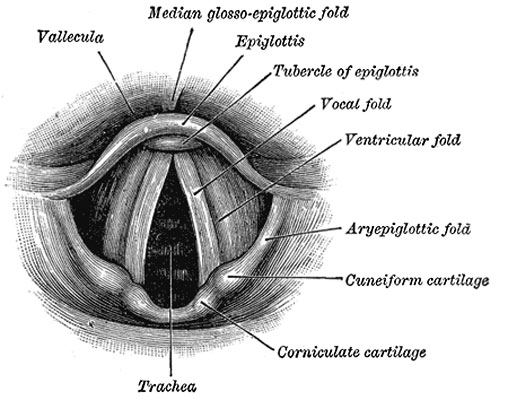File:Gray0956.jpg
Gray0956.jpg (508 × 400 pixels, file size: 49 KB, MIME type: image/jpeg)
Larynx Interior Laryngoscopic View
The Rima Glottidis (Fig. 956) is the elongated fissure or chink between the vocal folds in front, and the bases and vocal processes of the arytenoid cartilages behind. It is therefore subdivided into a larger anterior intramembranous part (glottis vocalis), which measures about three-fifths of the length of the entire aperture, and a posterior intercartilaginous part (glottis respiratoria). Posteriorly it is limited by the mucous membrane passing between the arytenoid cartilages. The rima glottidis is the narrowest part of the cavity of the larynx, and its level corresponds with the bases of the arytenoid cartilages.
Its length, in the male, is about 23 mm; in the female from 17 to 18 mm.
The width and shape of the rima glottidis vary with the movements of the vocal folds and arytenoid cartilages during respiration and phonation.
In the condition of rest, i. e., when these structures are uninfluenced by muscular action, as in quiet respiration, the intramembranous part is triangular, with its apex in front and its base behind—the latter being represented by a line, about 8 mm. long, connecting the anterior ends of the vocal processes, while the medial surfaces of the arytenoids are parallel to each other, and hence the intercartilaginous part is rectangular.
During extreme adduction of the vocal folds, as in the emission of a high note, the intramembranous part is reduced to a linear slit by the apposition of the vocal folds, while the intercartilaginous part is triangular, its apex corresponding to the anterior ends of the vocal processes of the arytenoids, which are approximated by the medial rotation of the cartilages.
Conversely in extreme abduction of the vocal folds, as in forced inspiration, the arytenoids and their vocal processes are rotated lateralward, and the intercartilaginous part is triangular in shape but with its apex directed backward. In this condition the entire glottis is somewhat lozenge-shaped, the sides of the intramembranous part diverging from before backward, those of the intercartilaginous part diverging from behind forward—the widest part of the aperture corresponding with the attachments of the vocal folds to the vocal processes.
(Text modified from Gray's 1918 Anatomy)
- Larynx Image Links: All cartilages of the larynx | Epiglottis cartilage | Thyroid cartilage | Cricoid cartilage | Arytenoid cartilage | Larynx ligaments anterior | Larynx ligaments posterior | Larynx sagittal section | Larynx and upper trachea | Larynx entrance | Larynx interior | Larynx muscular attachments | Larynx muscles 1 | Larynx muscles 2 | Larynx muscles 3 | Cartilage Development | Respiratory System Development
- Gray's Images: Development | Lymphatic | Neural | Vision | Hearing | Somatosensory | Integumentary | Respiratory | Gastrointestinal | Urogenital | Endocrine | Surface Anatomy | iBook | Historic Disclaimer
| Historic Disclaimer - information about historic embryology pages |
|---|
| Pages where the terms "Historic" (textbooks, papers, people, recommendations) appear on this site, and sections within pages where this disclaimer appears, indicate that the content and scientific understanding are specific to the time of publication. This means that while some scientific descriptions are still accurate, the terminology and interpretation of the developmental mechanisms reflect the understanding at the time of original publication and those of the preceding periods, these terms, interpretations and recommendations may not reflect our current scientific understanding. (More? Embryology History | Historic Embryology Papers) |
| iBook - Gray's Embryology | |
|---|---|

|
|
Reference
Gray H. Anatomy of the human body. (1918) Philadelphia: Lea & Febiger.
Cite this page: Hill, M.A. (2024, April 27) Embryology Gray0956.jpg. Retrieved from https://embryology.med.unsw.edu.au/embryology/index.php/File:Gray0956.jpg
- © Dr Mark Hill 2024, UNSW Embryology ISBN: 978 0 7334 2609 4 - UNSW CRICOS Provider Code No. 00098G
File history
Click on a date/time to view the file as it appeared at that time.
| Date/Time | Thumbnail | Dimensions | User | Comment | |
|---|---|---|---|---|---|
| current | 18:34, 21 August 2012 |  | 508 × 400 (49 KB) | Z8600021 (talk | contribs) | == Laryngoscopic view of interior of larynx== The Rima Glottidis (Fig. 956) is the elongated fissure or chink between the vocal folds in front, and the bases and vocal processes of the arytenoid cartilages behind. It is therefore subdivided into a larger |
You cannot overwrite this file.
File usage
The following 5 pages use this file:

